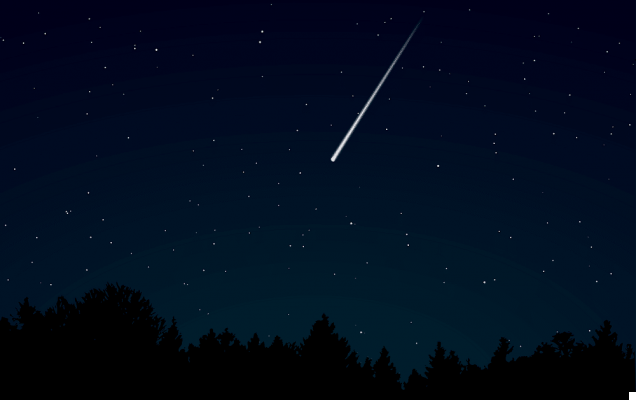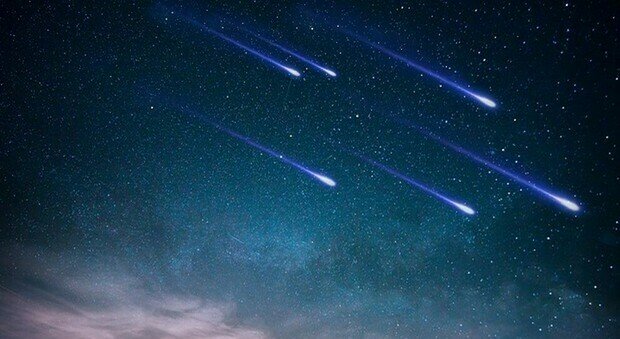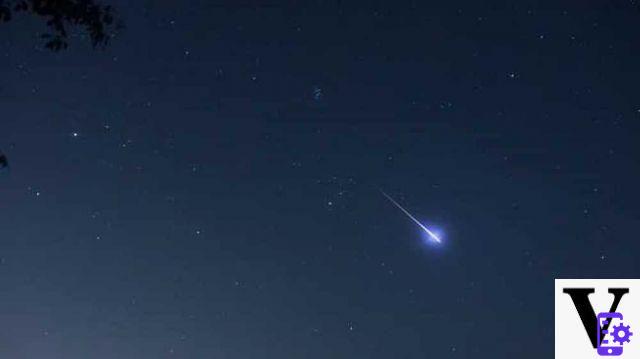What is a shooting star? As many of you will know, the night of San Lorenzo is approaching and it is good to be prepared on the topic that characterizes this particular night: that is shooting stars. Have you ever wondered what they are and how to observe them from your home? Let's try to discover all this and much more together.
Discovering the sky: what is a shooting star?

Let's start with the basics: what is a shooting star? A shooting star, whose real name is meteor, it's a asteroid fragment or of an other celestial body which ignites at the precise moment it enters the earth's atmosphere. Why does it catch fire? Very simple, due to thefriction with the aforementioned atmosphere.
You must know that meteors enter the Earth's atmosphere at a rather high speed, which is hovering between 11 and about 70 km / s: this means that they undergo a high dynamic pressure which, automatically, heats their surface.
Furthermore, each collision with the air molecules releases thermal energy of 100 electron volts (unit of measurement of energy). This means that at a height of approx 90 km, the shooting star temperature reaches i 2500 kelvin (which equates to about 2220 degrees Celsius). At that precise moment, matter begins to sublimation (then passes from solid state to gaseous).
As it continues its fall, a process known as ablation, or process of removal of material from the surface of an object. What does it mean? It means that the shooting star slowly starts at lose mass, leaving behind molten matter.
Automatically the atoms of the meteor and the atmospheric molecules, due to the continuous and reciprocal collisions, yes ionize. How does this whole scientific show translate down to Earth? With a bright trail, or the meteor.
From the ground the observer will be able to observe this incredible phenomenon and also to recognize the various parts of the shooting star. A meteor is in fact composed of two parts, the head and the wake. The head is the part that contains the meteoroid which gradually deteriorates, surrounded by ionized gases. The trail is instead one long column of plasma (ionized gas): this part, however, it is only visible for a few seconds.
If you are passionate about astronomy or just love to observe this amazing phenomenon, you must know that the best time to do it is around the August 10th (often even a few days before or after). In fact, on 10 August the Night of San Lorenzo, which is associated with the passage of the Perseid meteor shower: the earth's atmosphere, in this evening, is in fact crossed by a higher number of meteors.
This phenomenon is commonly (and also erroneously) known as shooting stars or St. Lawrence's tears. It is a truly wonderful phenomenon to be able to observe and it is also visible to the human eye, particularly because the summer sky is serene and clear.
Is there a difference between a shooting star and a meteor?
A little while ago we said that the meteors, often and willingly, come wrongly called shooting stars. In reality they are two different concepts: or rather, they represent two separate moments of the same phenomenon. Below we try to explain it to you in a simple and concise way.
- Shooting star: this term means the luminous trace (meteor trail), visible to the human eye for a few moments, left in the sky by the meteor as it crosses the Earth's atmosphere.
- Meteora: with this term, instead, we mean a rock particle that overheats and destroys as soon as it enters the earth's atmosphere at a high speed.
READ ALSO: How to experience a hi-tech dinner under the stars
Why do you make a wish?

What's the first thing you do as soon as you see a shooting star? Make a wish. We all, in one way or another, have done it but for what reason? How was this legend, this custom born? There are various theories: the first concerns sailors.
In the past, for the ancient sailors observing the sky was the safest way to reach your destination safe and sound.
Stargazing was indeed the only way to orient yourself in the sea during the night. The sailors who orient themselves in this way, had inside them the burning desire to be able to return home and hug your family again. According to this theory, therefore, it has started connect the stars to desires.
Many, on the other hand, link wishes and stars to De Bello Gallico, the work written by Julius Caesar. In the opera, soldiers who had to stay awake at night and stand guard after a battle were called out longing. The prefix "de" suggests a movement from top to bottom while the noun "sidus, sideris" means "Star, star".
This term has been given the meaning of "Gaze deeply at the stars". These soldiers, under the starlight, had to scan the horizon in the hope of being able to see their wounded comrades lift and then help them, taking them back to the camp. This means that the soldiers kept watch and they looked at the horizon with hope and the stars were the only source of light capable of giving him strength.
According to other sources, in ancient times it was believed that ours fate was written in the stars. In fact, they could be observed in the sky the moment an individual was born and, by constantly observing them, it was possible to determine what would happen in life of a person. This stargazing method is often used to determine the future of principles o of kings.
This means that the moment a star falls, fate is no longer written and can be changed: that's why when a shooting star falls, for a very few moments, man has the ability to change his future. It is a brief moment, precisely because it turns out to be important e rare.
When to observe shooting stars?

The Night of San Lorenzo is celebrated on 10 August but it will not be the only night in which to observe the shooting stars. In fact, it seems that this year we will have more days to be able to admire this incredible show. According to some sources, the star shower will peak there night of the 12 August, a few days after the new moon. This means that the moon will not give us problems and the sky will be dark enough to be able to observe the sky.
On the night of August 12 you can watch the shooting stars around eleven in the evening, or even towards the midnight.
To observe them in the best possible way, we therefore advise you to turn off all the lights in your home and yours garden: the ideal would be to be in a place completely in the dark, away from the city lights. As we said earlier, the Moon shouldn't create problems: this means that it will be possible to better observe the incredible spectacle.
Finally, remember to point your gaze towards the radiant. If you want to see the Perseids, then you have to look for the constellation of Perseus. You can help yourself with some a map of the sky or even with smartphone apps for stargazing. If, on the other hand, you need more information and advice on how to see shooting stars during the Night of San Lorenzo, you can consult the our article.
Discount The maps of the sky. An easy guide to recognize ... 14,90 EUR −5% 14,15 EUR Buy on Amazon Tagswatch the stars meteor Shooting star Shooting stars
What is a shooting star?
The maps of the sky. An easy guide to recognize ... 14,90 EUR −5% 14,15 EUR Buy on Amazon Tagswatch the stars meteor Shooting star Shooting stars
What is a shooting star?




















![[Review] Samsung Powerbot VR7000: the robot vacuum cleaner from Star Wars](/images/posts/6bc44de38605b5c0fa12661febb1f8af-0.jpg)





